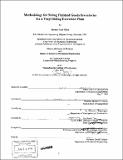| dc.contributor.advisor | Stephen C. Graves and Deborah J. Nightingale. | en_US |
| dc.contributor.author | Milby, Michael Gary, 1965- | en_US |
| dc.date.accessioned | 2005-09-26T19:09:55Z | |
| dc.date.available | 2005-09-26T19:09:55Z | |
| dc.date.copyright | 1999 | en_US |
| dc.date.issued | 1999 | en_US |
| dc.identifier.uri | http://hdl.handle.net/1721.1/28213 | |
| dc.description | Thesis (S.M.)--Massachusetts Institute of Technology, Sloan School of Management; and, (S.M.)--Massachusetts Institute of Technology, Dept. of Mechanical Engineering, 1999. | en_US |
| dc.description | Includes bibliographical references (p. 61). | en_US |
| dc.description.abstract | Recently, many companies have begun to implement lean manufacturing principles as a way to improve their production systems. Alcoa has joined the movement to adopt lean manufacturing, and has named their effort the Alcoa Production System (APS), after the Toyota Production System which is, doubtless, the best known example of lean manufacturing implementation. The thrust of lean manufacturing is the removal of waste from the production system. For most companies the biggest reason for implementing lean manufacturing is that of reducing excess inventory. However, before inventory can be removed it is important that the reasons for holding inventory are understood. Only after these drivers of inventory are improved or removed, can companies safely reduce their inventories without losing their ability to satisfy customer demand. If implemented correctly, lean manufacturing is a great way to systematically reduce waste, especially inventory. However, most reference texts on lean manufacturing implementation have very little specific information on how much inventory is appropriate at any stage of improvement. On the other hand, practitioners of operations management have been dealing with these issues for years, and there exists a body of knowledge on sizing inventories. Many fail to realize that these two fields of study are compatible and that the base stock model is fully compatible with lean production methods. It is the objective of this thesis to show that the base stock model is compatible with lean manufacturing, and is an appropriate model for determining the correct levels of finished goods inventories at the Denison Alcoa plant. | en_US |
| dc.description.statementofresponsibility | by Michael Gary Milby. | en_US |
| dc.format.extent | 69 p. | en_US |
| dc.format.extent | 4604672 bytes | |
| dc.format.extent | 4611712 bytes | |
| dc.format.mimetype | application/pdf | |
| dc.format.mimetype | application/pdf | |
| dc.language.iso | en_US | |
| dc.publisher | Massachusetts Institute of Technology | en_US |
| dc.rights | M.I.T. theses are protected by copyright. They may be viewed from this source for any purpose, but reproduction or distribution in any format is prohibited without written permission. See provided URL for inquiries about permission. | en_US |
| dc.rights.uri | http://dspace.mit.edu/handle/1721.1/7582 | |
| dc.subject | Sloan School of Management | en_US |
| dc.subject | Mechanical Engineering | en_US |
| dc.title | Methodology for sizing finished goods inventories for a vinyl siding extrusion plant | en_US |
| dc.type | Thesis | en_US |
| dc.description.degree | S.M. | en_US |
| dc.contributor.department | Massachusetts Institute of Technology. Department of Mechanical Engineering | en_US |
| dc.contributor.department | Sloan School of Management | en_US |
| dc.identifier.oclc | 42828112 | en_US |
